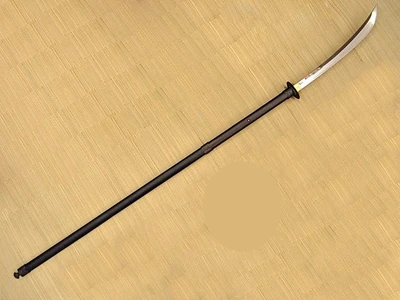Butterfly swords actually have a variety of different names, depending on the context of both the time period, and the martial arts style using them. For example:
- Wing Chun calls them Baat Jaám Doū (八斬刀 lit. eight hacking knives),
- Choi Leí Faht calls them Moúhjí Doū (母子刀 lit. mother and child knives)
- Jaū Gā (周家) style calls them Baaū Jaú Doū (包肘刀 lit. wrap elbow knives)
- and to sailors, pirates, and rebel groups in the late nineteenth century, they were called Hùhng Syùhn Doū (紅船刀 lit. red boat knives).
While there are no official records of Butterfly Swords being standard weapons in the Chinese army, there are records of them being common among local militiamen, especially in the Southern province of Guǎngdōng (廣東省)
Keeping much in the same tradition of dual weapons, both Butterfly swords are identical, or at least are mirror images of each other. They were designed to be symmetrical, with half-circle handles, so they both could fit into a single scabbard. The longer Dual Sabers or Shuāng Dāo (雙刀) also use this same design. It is possible that this aspect of Butterfly Swords design were based off of earlier Shuang Dao.
 |
| an antique pair of Shuang Dao (雙刀) |
While most modern types of Butterfly Swords have a very wide profile, most historical versions do not. In fact, most have a very steep profile taper, ending in a very narrow sharp point. Some even had a small secondary edge at the tip. This suggests that in the past, they were more designed for stabbing and slicing, and were actually less effective at hacking and chopping.
 |
| An antique pair of Hudie Dao, likely from the 1860's or earlier |
The other historical oddity is that in addition to their profile design being different, their edge geometry was also quite different. I've seen several examples of historical Butterfly swords that have a triangular cross section, or chisel grind, instead of the typical convex or V-grind that you see on modern sharpened Butterfly sabers (this change may have come about because nearly all practice versions used by martial artists today are blunt).
Butterfly swords are single edged, and very short, with their blades being typically between 12-14" in length, although historically they were longer (18-20"). This meant that they were optimized for close quarters combat. Thickness in historical examples varied between 1/3" and 1/2" thick at the base and had a distal taper, unlike modern ones which have a fairly uniform thickness down the entire length of the blade.
Width wise they are 2 1/2" to 3" at the base of the blade. Handle length was around 4". They typically weighed between 1-2 lbs. for each sword.
The thing that distinguishes butterfly swords from other weapons, aside from their length, is the design of hand guard they use. It consists of a fully enclosed brass knuckle guard, or D-guard.
It also had an upward facing prong, placed on the opposite side of the handle. According to martial artists, the prong, or quillon, was designed to catch an opponents weapon, but I believe it may have been designed simply to protect the user's wrist and forearm in a bind.
But it has also been suggested that the butterfly sword's guard design was loosely based off of sabers, worn by European sailors, who traded with the Chinese at Guangzhou 廣州 (aka Canton) in the 18th and 19th centuries. (note: the quillons of today's butterfly swords are also much longer than they were in the past.)
 |
| a British Naval Officer's Saber. 1780 |
Another myth that has been perpetuated (in Season 2, Episode 3 of the History Channel's Forged in Fire.) is that only the upper two thirds of the edge are sharpened. And they say it is either in order to hold it in a reverse grip, or because the Shaolin monks wanted to be able to deal nonlethal attacks when using the weapon.
This is untrue on both points. The Shaolin warrior monks from Henan province, never used this weapon historically, as far as I know. By the way, how could you safely hit somebody with only the bottom third of the edge anyway?
As a side note, I have already heard this same myth, about an unsharpened lower part of the blade, applied to the Chinese Jian, (劍) or double edged straight sword, and it is just as historically untrue in that regard.
The entire edge on any historical Chinese blade is supposed to be sharp. There was no concept of a ricasso (an unsharpened section of blade just before the handle) and wasn't used in China until they started making blades industrially, in the modern Western style.
Besides, you do not even touch the edge of a Butterfly Sword when you hold it properly in a reverse grip. Here is a GIF that shows the incorrect and correct way to hold a butterfly sword in a reverse grip.
Incidentally, I am in no way condemning the show, Forged in Fire. I am a tremendous fan of theirs. I just hold them to a somewhat higher standard than most, due to my knowledge of weapons and history, among other things.
This concludes my series on Dual Weapons. Let me know in the comments if you liked this, or if you want to see another series of posts like this in the future.













